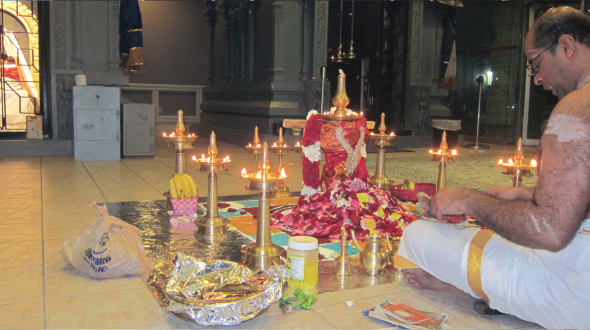Blissful Bhagavathi Seva Performed at MTS

Sri Durga Parameswari invoked through the beautifully decorated lamps at Bhagavathi Seva conducted at Sri Meenakshi Temple.
By Chittoor Ramachandran
PEARLAND: Sri Meenakshi temple of Pearland is highly revered for its established tradition of following the ritualistic practices based on ancient Hindu texts in Siva-Shakthi upasana . The procedure of worship in this temple (as per Agama shastra) primarily follow the practice of Madurai Sri Meenakshi Temple of Tamil Nadu. Through a variety of rituals, celebrations, festivals, social events and religious teaching year around, this temple has gained nationwide reputation as a Hindu pilgrimage center for worshipping (especially) Sri Meenakshi (Mother Goddess, Devi, Durga, Parashakthi).
On astrologically significant occasions (a few times a year) the temple performs special poojas with unique characteristics and formats. The highly respected Bhagavathi Seva conducted on Friday, March 14 was one such ritual in the worship of Devi, the pooja familiar in the temples and homes of Kerala and Southern Karnataka.
Although the tradition of Bhagavathi Seva existed in the worship many centuries ago based on Tantric Principles, it was Bhaskararayar (1690–1785 CE) who is widely considered to be the authority who systematized the current Devi worship procedures (pooja vidhi) including Bhagavathi seva.
By sunset on March 14, many ardent Devi devotees assembled at Sri Ayyappa sannidhi where the pooja was performed. Much preparation obviously went in ahead of time as the priest Sri Parameswaran lighted the oil lamps to initiate the pooja. He, hailing from the lineage of disciples of Sri Bhaskararayer, trained at Sri Vidya Upasana Peedham in Tamil Nadu had his mind set to perform a significant ritual. Using rice flour, kumkum (vermilion) and turmeric powder he drew the design of Ashtadala padmam ( Durga padmam) on the floor. After drawing the padmam, he placed five glittering bronze lamps (Nilavilakku) filled with ghee (purified butter) and the wicks on top of the padmam. The lamp placed at the center was decorated with flowers and a red silk decorative piece of cloth. Immediately after all the lamps were lighted, the priest started the pooja that involved several mystic hand gestures, familiar only to the trained Devi upasakas. The serene expression of the priest with closed eyes was indicative of this as the invoking procedure. In the aradhana that followed, the priest performed pooja on each lighted lamp representing Guru, Sri Ganesha and Sri Durga Parameswari in sequence who were all invoked. The devotees were permitted to join him in the recital of certain passages like Lalitha Sahasranamam.
The ambience during the entire duration of the pooja was pious, calm and intensively focused on spiritually uplifting names of Devi. The copious shower of rose petals and the fragrance of camphor and burning ghee added divinity of the surroundings. The blissful feeling it infused in the devotees was beyond words.
The pooja predominantly employed recitation of several passages from the highly regarded scriptures including Brahmanda purana ( Lalitha sahasranamam and Lalitha ashtotharam , which enumerate the meaning-embedded divine names of Parashakthi), selected stanzas from Devi Mahatmyam (Durga Sapthashathi; from Markandeya Purana that describes the glory of the Mother Goddess) and portions of Soundarya Lahari ( which extol Parashakthi, the consort of Siva, as the creative energy of the universe – based on Adi Shankara’s bhashyam).
In the concluding rituals, the priest gracefully honored the Goddess with gratitude for her continued blessing and mercy towards the devotees. With the reaffirmed trust in Devi, the devotees prostrated to express their unconditional surrender to Sri Durga Parameswari. This pooja was coordinated by Sri Sasidharan Pillai and the religious committee.
